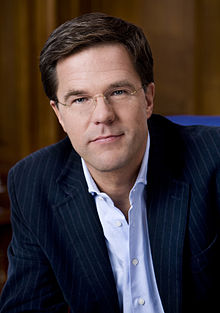Mark Rutte
| Mark Rutte | |
|---|---|
 |
|
| 50th Prime Minister of the Netherlands | |
|
Assumed office 14 October 2010 |
|
| Monarch |
Beatrix Willem-Alexander |
| Deputy |
Maxime Verhagen Lodewijk Asscher |
| Preceded by | Jan Peter Balkenende |
| Leader of the People's Party for Freedom and Democracy | |
|
Assumed office 31 May 2006 |
|
| Preceded by | Jozias van Aartsen |
| Undersecretary for Higher Education and Science | |
|
In office 17 June 2004 – 27 June 2006 |
|
| Prime Minister | Jan Peter Balkenende |
| Preceded by | Annette Nijs |
| Succeeded by | Bruno Bruins |
| Undersecretary for Municipal welfare and Occupational safety | |
|
In office 22 July 2002 – 17 June 2004 |
|
| Prime Minister | Jan Peter Balkenende |
| Preceded by | Hans Hoogervorst |
| Succeeded by | Henk van Hoof |
| Member of the House of Representatives | |
|
In office 15 May 2002 – 27 May 2003 |
|
|
In office 28 June 2006 – 14 October 2010 |
|
|
In office 20 September 2012 – 5 November 2012 |
|
| Personal details | |
| Born |
14 February 1967 The Hague, Netherlands |
| Political party | People's Party for Freedom and Democracy |
| Residence | Catshuis |
| Alma mater | Leiden University |
| Signature | |
| Website | Government website |
Mark Rutte (Dutch pronunciation: [ˈmɑrk ˈrɵtə]; born 14 February 1967) is a Dutch politician who has been the Prime Minister of the Netherlands since 14 October 2010, and the Leader of the People's Party for Freedom and Democracy (Volkspartij voor Vrijheid en Democratie - VVD) since 31 May 2006.
Rutte previously served as Undersecretary for Social Affairs and Employment from 22 July 2002 to 17 June 2004, and Undersecretary for Education, Culture and Science from 17 June 2004 until 27 June 2006, when he was elected to succeed Jozias van Aartsen as the new VVD Leader.
At the 2006 general election, the People's Party for Freedom and Democracy under Rutte lost six seats, and he became Opposition Leader. At the following general election in 2010, the VVD won the highest number of votes cast, resulting in their occupying 31 of the 150 seats in the House of Representatives.
After a long formation period, Rutte became Prime Minister and formed a Cabinet. When Rutte was sworn in on 14 October 2010, he became the first liberal Prime Minister of the Netherlands in 92 years. Rutte offered his government's resignation on 23 April 2012, after an impasse in talks on an austerity budget, prompting a general election in which the VVD won its highest number of seats ever, which led to a coalition being formed with the VVD and Labour Party. On 5 November 2012, the Second Rutte cabinet was installed by Queen Beatrix.
...
Wikipedia
